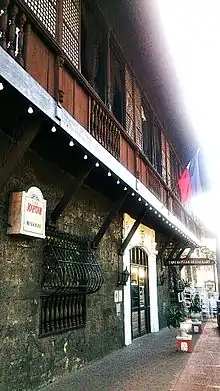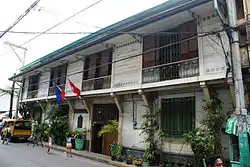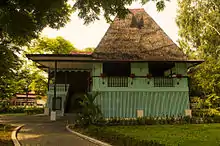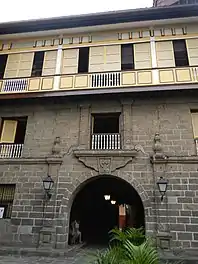
In Philippine architecture, the ventanilla is a small window or opening below a larger window's casement, created—often reaching the level of the floor—to allow either additional air into a room during hot days or some air during hot nights when the main window's panes are drawn.[1][2][3] It also allows for more light to strike the floor.[4]
The ventanilla is often used on upper floor windows, as in the bahay na bato. As the lower part of a composite window, its larger upper part is typically a window with sliding capiz-shell panes. The ventanilla is just under this upper large window's sill and is typically made with sliding panel-covers behind balusters or grills.[5][3]
Bobby Mañosa's traditional methods for his design of the Coconut Palace is considered as displaying a fine example of how ventanillas can be applied in modern Philippine architecture.[5]
Gallery
 Side view of the wooden ventanilla balusters of the Kapitan Moy Residence.
Side view of the wooden ventanilla balusters of the Kapitan Moy Residence. Opened ventanillas at the Bahay Nakpil-Bautista, boasting their lyre-shaped grilles.
Opened ventanillas at the Bahay Nakpil-Bautista, boasting their lyre-shaped grilles. The large front windows of Apolinario Mabini's bahay kubo house augmented by ventanillas.
The large front windows of Apolinario Mabini's bahay kubo house augmented by ventanillas. Ventanillas of Casa Manila.
Ventanillas of Casa Manila.
References
- ↑ Shewakramani, Jasmine (August 25, 2022). "5 Filipino Architecture Design Ideas". realliving.com.ph. Retrieved April 4, 2023.
- ↑ Real Living Team (September 7, 2018). "Five Houses and Buildings Show The Best of Filipino Design". realliving.com.ph. Retrieved April 4, 2023.
- 1 2 Antonio, Senen. "Lean Interpretations from Philippine Vernacular Architecture | Lean Urbanism". Retrieved 2023-04-04.
- ↑ IV, Franz Sorilla. "Bahay Na Bato: The Parts Of A Stately Filipino House During The Spanish Colonial Period". Tatler Asia. Retrieved 2023-04-04.
- 1 2 Ogura, Nobuyuki; David Leonides T. Yap; and Kenichi Tanoue. "Modern Architecture in the Philippines and the Quest for Filipino Style". J-STAGE (November 2002): 3–4.
{{cite journal}}: CS1 maint: multiple names: authors list (link)